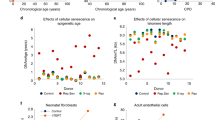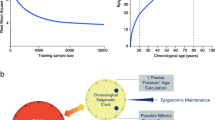Abstract
Telomere length (TL) and DNA methylation–based epigenetic clocks are markers of biological age, but the relationship between the two is not fully understood. Here, we used multivariable regression models to evaluate the relationships between leukocyte TL (LTL; measured by qPCR [n = 635] or flow FISH [n = 144]) and five epigenetic clocks (Hannum, DNAmAge pan-tissue, PhenoAge, SkinBlood, or GrimAge clocks), or their epigenetic age acceleration measures in healthy adults (age 19–61 years). LTL showed statistically significant negative correlations with all clocks (qPCR: r = − 0.26 to − 0.32; flow FISH: r = − 0.34 to − 0.49; p < 0.001 for all). Yet, models adjusted for age, sex, and race revealed significant associations between three of five clocks (PhenoAge, GrimAge, and Hannum clocks) and LTL by flow FISH (p < 0.01 for all) or qPCR (p < 0.001 for all). Significant associations between age acceleration measures for the same three clocks and qPCR or flow FISH TL were also found (p < 0.01 for all). Additionally, LTL (by qPCR or flow FISH) showed significant associations with extrinsic epigenetic age acceleration (EEAA: p < 0.0001 for both), but not intrinsic epigenetic age acceleration (IEAA; p > 0.05 for both). In conclusion, the relationships between LTL and epigenetic clocks were limited to clocks reflecting phenotypic age. The observed association between LTL and EEAA reflects the ability of both measures to detect immunosenescence. The observed modest correlations between LTL and epigenetic clocks highlight a possible benefit from incorporating both measures in understanding disease etiology and prognosis.

Similar content being viewed by others
References
Hannum G, Guinney J, Zhao L, Zhang L, Hughes G, Sadda S, et al. Genome-wide methylation profiles reveal quantitative views of human aging rates. Mol Cell. 2013;49(2):359–67. https://doi.org/10.1016/j.molcel.2012.10.016.
Horvath S. DNA methylation age of human tissues and cell types. Genome Biol. 2013;14(10):R115. https://doi.org/10.1186/gb-2013-14-10-r115.
Horvath S, Oshima J, Martin GM, Lu AT, Quach A, Cohen H, et al. Epigenetic clock for skin and blood cells applied to Hutchinson Gilford progeria syndrome and ex vivo studies. Aging (Albany NY). 2018;10(7):1758–75. https://doi.org/10.18632/aging.101508.
Horvath S, Raj K. DNA methylation-based biomarkers and the epigenetic clock theory of ageing. Nat Rev Genet. 2018;19(6):371–84. https://doi.org/10.1038/s41576-018-0004-3.
Lu AT, Quach A, Wilson JG, Reiner AP, Aviv A, Raj K, et al. DNA methylation GrimAge strongly predicts lifespan and healthspan. Aging (Albany NY). 2019;11(2):303–27. https://doi.org/10.18632/aging.101684.
Blackburn EH. Structure and function of telomeres. Nature. 1991;350(6319):569–73. https://doi.org/10.1038/350569a0.
Aubert G, Lansdorp PM. Telomeres and aging. Physiol Rev. 2008;88(2):557–79. https://doi.org/10.1152/physrev.00026.2007.
O’Sullivan RJ, Karlseder J. Telomeres: protecting chromosomes against genome instability. Nat Rev Mol Cell Biol. 2010;11(3):171–81. https://doi.org/10.1038/nrm2848.
Counter CM. The roles of telomeres and telomerase in cell life span. Mutat Res. 1996;366(1):45–63. https://doi.org/10.1016/s0165-1110(96)90006-8.
Feldser DM, Hackett JA, Greider CW. Telomere dysfunction and the initiation of genome instability. Nat Rev Cancer. 2003;3(8):623–7. https://doi.org/10.1038/nrc1142.
Aubert G, Hills M, Lansdorp PM. Telomere length measurement-caveats and a critical assessment of the available technologies and tools. Mutat Res. 2012;730(1–2):59–67. https://doi.org/10.1016/j.mrfmmm.2011.04.003.
Lai TP, Wright WE, Shay JW. Comparison of telomere length measurement methods. Philos Trans R Soc Lond B Biol Sci. 2018;373(1741). https://doi.org/10.1098/rstb.2016.0451
Blasco MA. Telomeres and human disease: ageing, cancer and beyond. Nat Rev Genet. 2005;6(8):611–22. https://doi.org/10.1038/nrg1656.
Chen BH, Marioni RE, Colicino E, Peters MJ, Ward-Caviness CK, Tsai PC, et al. DNA methylation-based measures of biological age: meta-analysis predicting time to death. Aging (Albany NY). 2016;8(9):1844–65. https://doi.org/10.18632/aging.101020.
Belsky DW, Moffitt TE, Cohen AA, Corcoran DL, Levine ME, Prinz JA, et al. Eleven telomere, epigenetic clock, and biomarker-composite quantifications of biological aging: do they measure the same thing? Am J Epidemiol. 2018;187(6):1220–30. https://doi.org/10.1093/aje/kwx346.
Vetter VM, Meyer A, Karbasiyan M, Steinhagen-Thiessen E, Hopfenmuller W, Demuth I. Epigenetic clock and relative telomere length represent largely different aspects of aging in the Berlin Aging Study II (BASE-II). J Gerontol A Biol Sci Med Sci. 2019;74(1):27–32. https://doi.org/10.1093/gerona/gly184.
Banszerus VL, Vetter VM, Salewsky B, Konig M, Demuth I. Exploring the relationship of relative telomere length and the epigenetic clock in the LipidCardio cohort. Int J Mol Sci. 2019;20(12). https://doi.org/10.3390/ijms20123032
Chen BH, Carty CL, Kimura M, Kark JD, Chen W, Li S, et al. Leukocyte telomere length, T cell composition and DNA methylation age. Aging (Albany NY). 2017;9(9):1983–95. https://doi.org/10.18632/aging.101293.
Marioni RE, Harris SE, Shah S, McRae AF, von Zglinicki T, Martin-Ruiz C, et al. The epigenetic clock and telomere length are independently associated with chronological age and mortality. Int J Epidemiol. 2018;45(2):424–32. https://doi.org/10.1093/ije/dyw041.
Pearce EE, Horvath S, Katta S, Dagnall C, Aubert G, Hicks BD, et al. DNA-methylation-based telomere length estimator: comparisons with measurements from flow FISH and qPCR. Aging (Albany NY). 2021;13(11):14675–86. https://doi.org/10.18632/aging.203126.
Bergsma T, Rogaeva E. DNA methylation clocks and their predictive capacity for aging phenotypes and healthspan. Neurosci Insights. 2020;15:2633105520942221. https://doi.org/10.1177/2633105520942221.
McCrory C, Fiorito G, Hernandez B, Polidoro S, O’Halloran AM, Hever A, et al. GrimAge outperforms other epigenetic clocks in the prediction of age-related clinical phenotypes and all-cause mortality. J Gerontol A Biol Sci Med Sci. 2021;76(5):741–9. https://doi.org/10.1093/gerona/glaa286.
Field AE, Robertson NA, Wang T, Havas A, Ideker T, Adams PD. DNA methylation clocks in aging: categories, causes, and consequences. Mol Cell. 2018;71(6):882–95. https://doi.org/10.1016/j.molcel.2018.08.008.
Jylhava J, Pedersen NL, Hagg S. Biological age predictors EBioMedicine. 2017;21:29–36. https://doi.org/10.1016/j.ebiom.2017.03.046.
Levine ME, Lu AT, Quach A, Chen BH, Assimes TL, Bandinelli S, et al. An epigenetic biomarker of aging for lifespan and healthspan. Aging (Albany NY). 2018;10(4):573–91. https://doi.org/10.18632/aging.101414.
Horvath S, Ritz BR. Increased epigenetic age and granulocyte counts in the blood of Parkinson’s disease patients. Aging (Albany NY). 2015;7(12):1130–42. https://doi.org/10.18632/aging.100859.
Horvath S, Levine AJ. HIV-1 infection accelerates age according to the epigenetic clock. J Infect Dis. 2015;212(10):1563–73. https://doi.org/10.1093/infdis/jiv277.
Carr EJ, Dooley J, Garcia-Perez JE, Lagou V, Lee JC, Wouters C, et al. The cellular composition of the human immune system is shaped by age and cohabitation. Nat Immunol. 2016;17(4):461–8. https://doi.org/10.1038/ni.3371.
Aubert G, Baerlocher GM, Vulto I, Poon SS, Lansdorp PM. Collapse of telomere homeostasis in hematopoietic cells caused by heterozygous mutations in telomerase genes. PLoS Genet. 2012;8(5):e1002696. https://doi.org/10.1371/journal.pgen.1002696 (leukocytetelomerelengthmeasurementsusingflowFISH.Allotherauthorsdeclarenocompetinginterestsexist).
Gadalla SM, Aubert G, Wang T, Haagenson M, Spellman SR, Wang L, et al. Donor telomere length and causes of death after unrelated hematopoietic cell transplantation in patients with marrow failure. Blood. 2018;131(21):2393–8. https://doi.org/10.1182/blood-2017-10-812735.
Steenstrup T, Kark JD, Verhulst S, Thinggaard M, Hjelmborg JVB, Dalgard C, et al. Telomeres and the natural lifespan limit in humans. Aging (Albany NY). 2017;9(4):1130–42. https://doi.org/10.18632/aging.101216.
Dagnall CL, Hicks B, Teshome K, Hutchinson AA, Gadalla SM, Khincha PP, et al. Effect of pre-analytic variables on the reproducibility of qPCR relative telomere length measurement. PLoS ONE. 2017;12(9):e0184098. https://doi.org/10.1371/journal.pone.0184098.
Wang Y, Savage SA, Alsaggaf R, Aubert G, Dagnall CL, Spellman SR, et al. Telomere length calibration from qPCR measurement: limitations of current method. Cells. 2018;7(11). https://doi.org/10.3390/cells7110183
Funding
This study was supported by the intramural research program of the Division of Cancer Epidemiology and Genetics, National Cancer Institute, National Institutes of Health. The Cancer Genomics Research Laboratory is funded with Federal funds from the National Cancer Institute, National Institutes of Health, under NCI Contract No. 75N910D00024.
The CIBMTR is supported primarily by Public Health Service U24CA076518 from the National Cancer Institute (NCI), the National Heart, Lung and Blood Institute (NHLBI), and the National Institute of Allergy and Infectious Diseases (NIAID); HHSH250201700006C from the Health Resources and Services Administration (HRSA); and N00014-20–1-2705 and N00014-20–1-2832 from the Office of Naval Research. Support is also provided by Be the Match Foundation, the Medical College of Wisconsin, the National Marrow Donor Program.
Author information
Authors and Affiliations
Contributions
Study design: Emily E. Pearce, Rotana Alsaggaf, and Shahinaz M. Gadalla. Sample acquisition: Stephen Spellman. Laboratory and bioinformatics: Geraldine Aubert, Casey L. Dagnall, Shilpa Katta, Steve Horvath, and Belynda Hicks. Statistical analysis: Emily E. Pearce and Rotana Alsaggaf. Data interpretation and manuscript drafting: Emily Pearce, Rotana Alsaggaf, Sharon Savage, and Shahinaz M. Gadalla. Manuscript critical review: all authors.
Corresponding author
Ethics declarations
Conflict of interest
The authors declare no competing interests.
Additional information
Publisher's note
Springer Nature remains neutral with regard to jurisdictional claims in published maps and institutional affiliations.
Supplementary Information
Below is the link to the electronic supplementary material.
About this article
Cite this article
Pearce, E.E., Alsaggaf, R., Katta, S. et al. Telomere length and epigenetic clocks as markers of cellular aging: a comparative study. GeroScience 44, 1861–1869 (2022). https://doi.org/10.1007/s11357-022-00586-4
Received:
Accepted:
Published:
Issue Date:
DOI: https://doi.org/10.1007/s11357-022-00586-4




